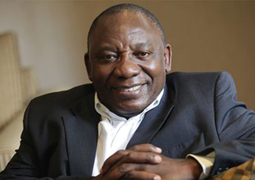
Faced with poor economic growth and the socio-economic hardships associated with the Covid-19 pandemic, President Cyril Ramaphosa delivered his Economic Reconstruction and Recovery Plan aimed at harnessing South Africa’s economic growth potential before a Joint Sitting of the National Assembly and the National Council of Province on Thursday, 15 October.
The President emphasised that the already weak economy has been further damaged by the pandemic, particularly with regard to employment, livelihoods, public finances and state-owned companies. “More than 2 million people lost their jobs in the second quarter of this year. Our economy contracted by 16.4% when compared to the previous quarter.”
The recovery plan is a response to this grim state of affairs, which is exacerbated by revenue shortfalls due to a decreasing tax base, a bloated public service wage bill, incapable state-owned enterprises, and rampant fraud and corruption. The plan is the result of wide-ranging consultations between government, the private sector, labour and civil society.
President Ramaphosa noted 45 areas that need to be addressed to bring about sustainable economic recovery, but the government decided to focus on four broad priority interventions. These include the roll out of infrastructure investment, energy generation, employment stimulus and the industrialisation of South African manufacturing sector. If these interventions are harnessed well, South Africa will secure sufficient and reliable energy supplies within two years, create over 800 000 jobs and unlock more than R1 trillion in infrastructure investment over the next four years.
Infrastructure remains one of the major drivers of government’s economic reconstruction and recovery plan, the President said. “Infrastructure has immense potential to stimulate investment and growth, to develop other economic sectors and create sustainable employment both directly and indirectly. We have developed a robust pipeline of projects that will completely transform the landscape of our cities, towns and rural areas.”
He stated that 50 strategic integrated projects and 12 special projects were gazetted in July 2020 to this effect. These were “prioritised for immediate implementation with all regulatory processes fast-tracked, enabling over R340 billion in new investment”. To facilitate the ease of implementing these projects, government has established Infrastructure SA and the Infrastructure Fund with the capacity to prepare and package projects.
The government will also concentrate of implementing the Integrated Resource Plan to increase the production of renewable energy, and improve battery storage and gas technology. The government estimates that this initiative will “bring around 11 800 MW of new generation capacity into the system by 2022”. More than half of this energy will be generated from renewable sources, the President said. He also announced that independent power producers will connect over 2 000 MW of additional capacity from existing projects by June 2021.
The third intervention is employment stimulus to create jobs and support livelihoods, with a focus on interventions that can be rolled out quickly and have the greatest impact. “We have committed R100 billion over the next three years to create jobs through public and social employment as the labour market recovers. This starts now, with over 800 000 employment opportunities created in the months ahead.”
President Ramaphosa then turned the Joint Sitting’s attention to industrialisation, which he said could bring about massive growth in local production and expand South Africa’s investment portfolio. He mentioned the investment conferences held before the pandemic, in which some R664 billion in new investment was pledged.
Speaking of the need to expand South Africa’s export market, he said: “We currently import around R1.1 trillion of goods, excluding oil, each year. If we were to manufacture just 10% of these goods locally, it is estimated that we could add two percentage points to our annual gross domestic product [GDP].”
The government believes that if well implemented, South Africa’s industrialisation growth path can take advantage of Africa’s growing import market. “The rest of Africa currently imports R2.9 trillion worth of manufactured goods from outside the continent each year. If South Africa were to supply just 2% of those goods, it would add 1.2 percentage points to our annual GDP,” the President pointed out. Furthermore, if the industrialisation initiatives reach their envisaged manufacturing potential, the economy will reach the target of R1.2 trillion in new investment by 2023 and could add around 2.5% to South Africa’s annual GDP.
Local manufacturing is an important part of South Africa’s economic reconstruction and recovery plan. To this end, the President urged South Africans to buy locally “to stimulate the recovery of local businesses and bring about a much-needed economic recovery.”
In his anticorruption crusade, President Ramaphosa cited the Public Procurement Bill as an instrument that will uproot corruption in government procurement processes and improve monitoring and accountability, “to ensure that every rand spent produces the desired value and support the economic recovery plan”.
As for state-owned enterprises, these need to be rationalised and require equity partners to bring in fresh capital to achieve self-sufficiency.
Abel Mputing
19 October 2020

